International HRM: HR Executive Plant Manager Portfolio Report
VerifiedAdded on 2022/12/05
|9
|2054
|97
Report
AI Summary
This portfolio report focuses on international human resource management, specifically addressing the challenge faced by an HR executive at New Oriental Education in selecting a plant manager for their expansion into Japan. The report examines key aspects such as organizational structure, cultural context, international training and development, and staffing considerations. It analyzes the complexities of cross-cultural management, the importance of adapting to different cultural norms, and the strategies for effective international training programs. The report also explores staffing strategies, including the use of overseas contractors. Ultimately, the report recommends Rachel Heiley as the ideal candidate, highlighting her experience, cultural adaptability, and potential to contribute to the company's success in the Japanese market. The report emphasizes the need for careful consideration of cultural differences and strategic planning to ensure a successful international venture.
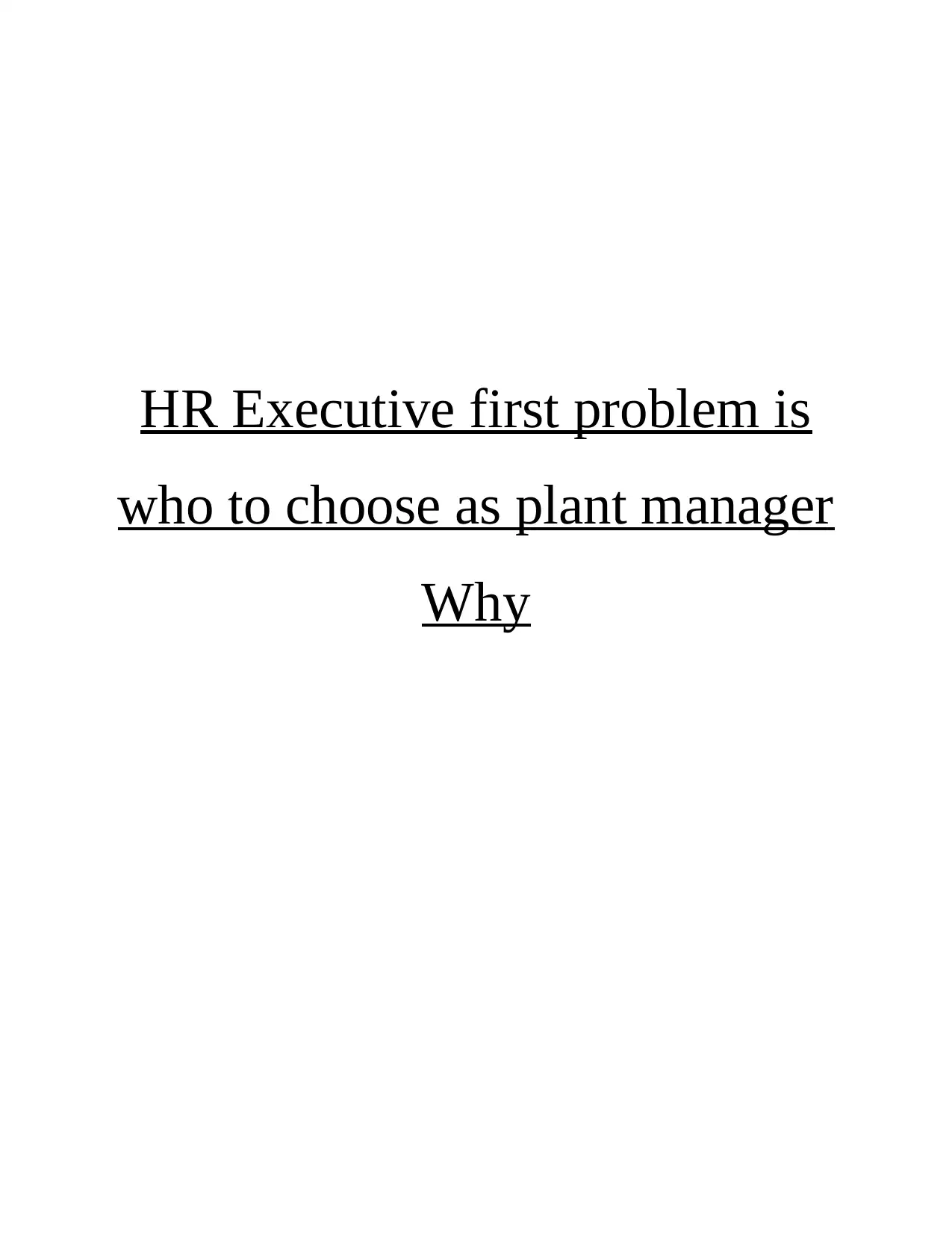
HR Executive first problem is
who to choose as plant manager
Why
who to choose as plant manager
Why
Paraphrase This Document
Need a fresh take? Get an instant paraphrase of this document with our AI Paraphraser
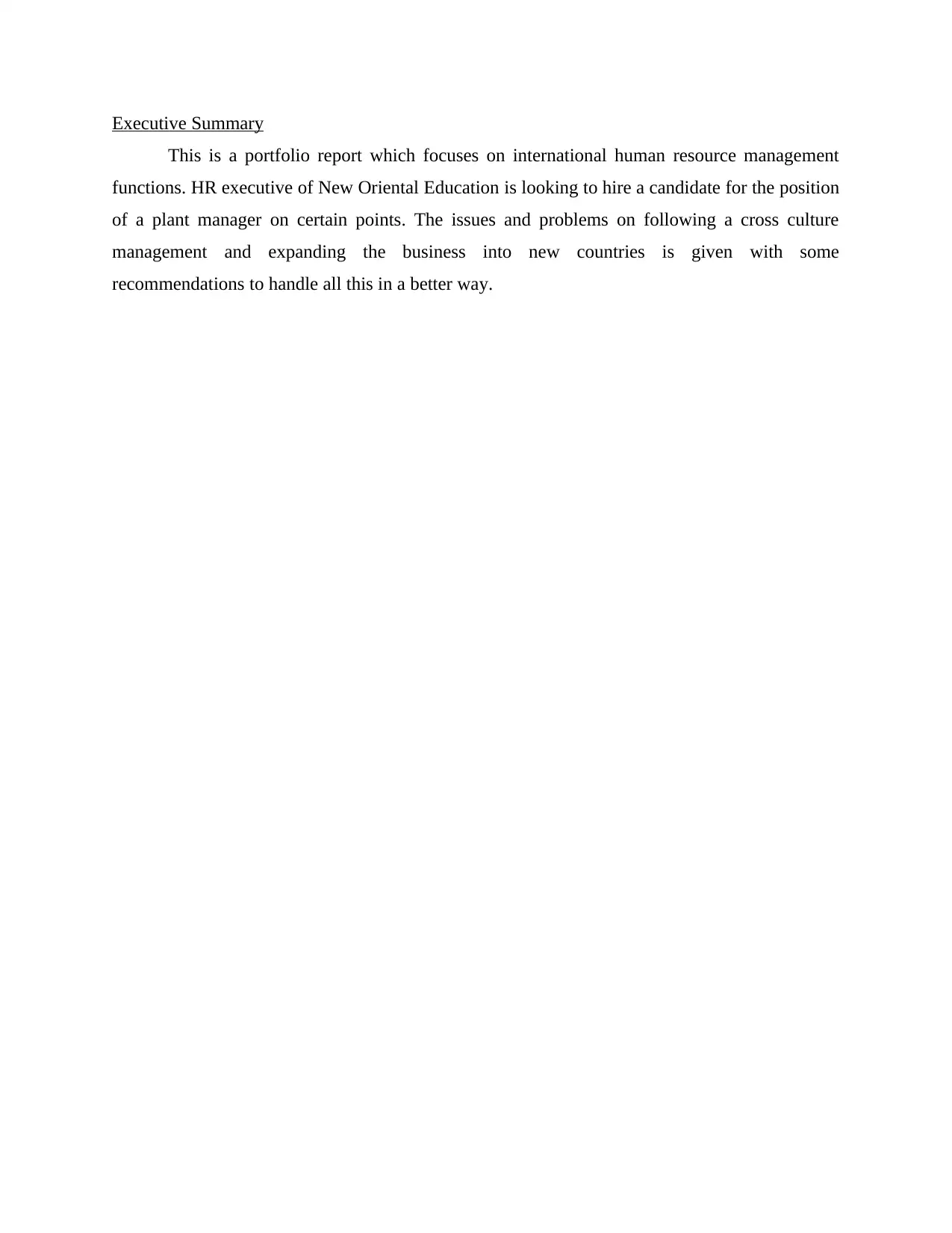
Executive Summary
This is a portfolio report which focuses on international human resource management
functions. HR executive of New Oriental Education is looking to hire a candidate for the position
of a plant manager on certain points. The issues and problems on following a cross culture
management and expanding the business into new countries is given with some
recommendations to handle all this in a better way.
This is a portfolio report which focuses on international human resource management
functions. HR executive of New Oriental Education is looking to hire a candidate for the position
of a plant manager on certain points. The issues and problems on following a cross culture
management and expanding the business into new countries is given with some
recommendations to handle all this in a better way.
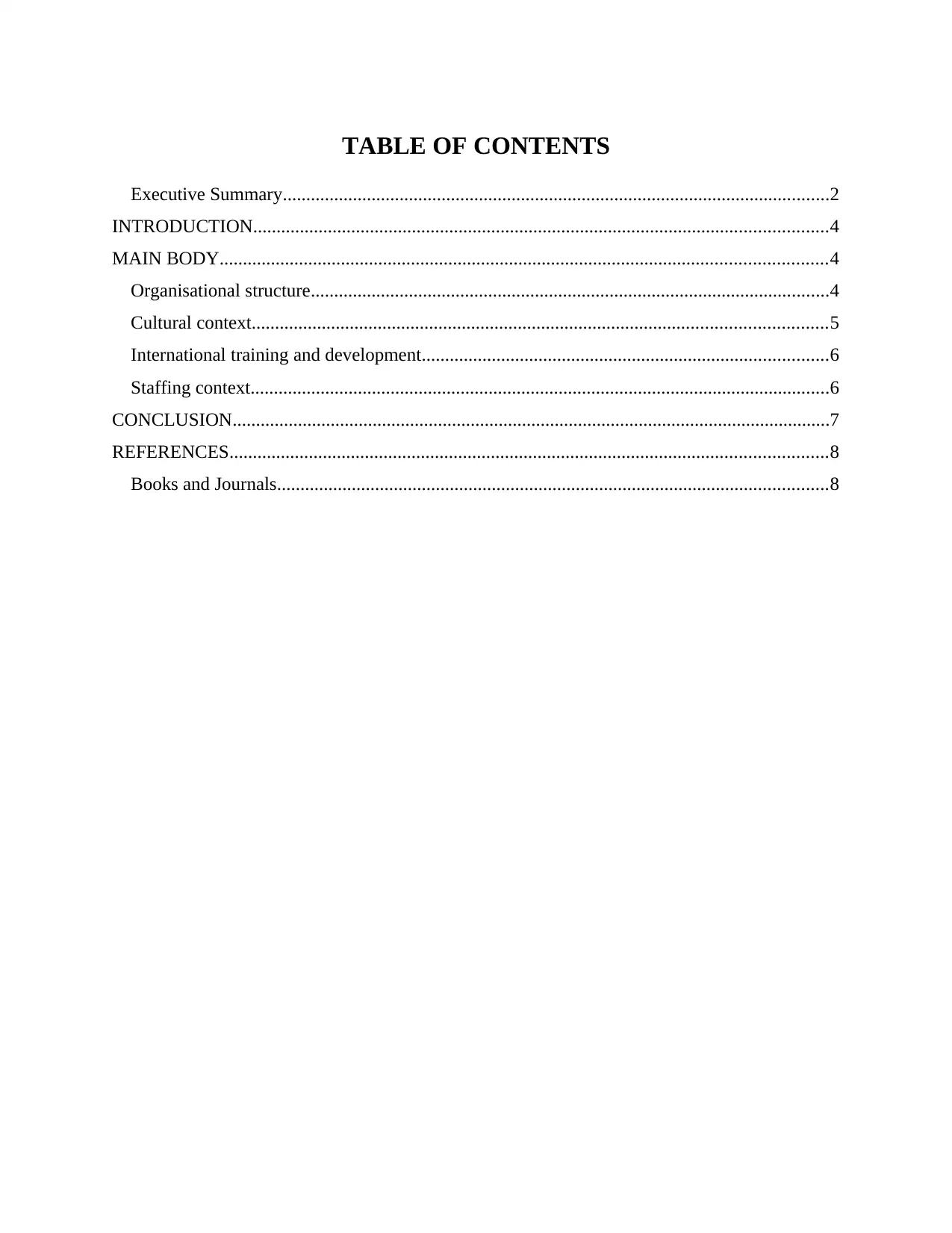
TABLE OF CONTENTS
Executive Summary.....................................................................................................................2
INTRODUCTION...........................................................................................................................4
MAIN BODY..................................................................................................................................4
Organisational structure...............................................................................................................4
Cultural context...........................................................................................................................5
International training and development.......................................................................................6
Staffing context............................................................................................................................6
CONCLUSION................................................................................................................................7
REFERENCES................................................................................................................................8
Books and Journals......................................................................................................................8
Executive Summary.....................................................................................................................2
INTRODUCTION...........................................................................................................................4
MAIN BODY..................................................................................................................................4
Organisational structure...............................................................................................................4
Cultural context...........................................................................................................................5
International training and development.......................................................................................6
Staffing context............................................................................................................................6
CONCLUSION................................................................................................................................7
REFERENCES................................................................................................................................8
Books and Journals......................................................................................................................8
⊘ This is a preview!⊘
Do you want full access?
Subscribe today to unlock all pages.

Trusted by 1+ million students worldwide
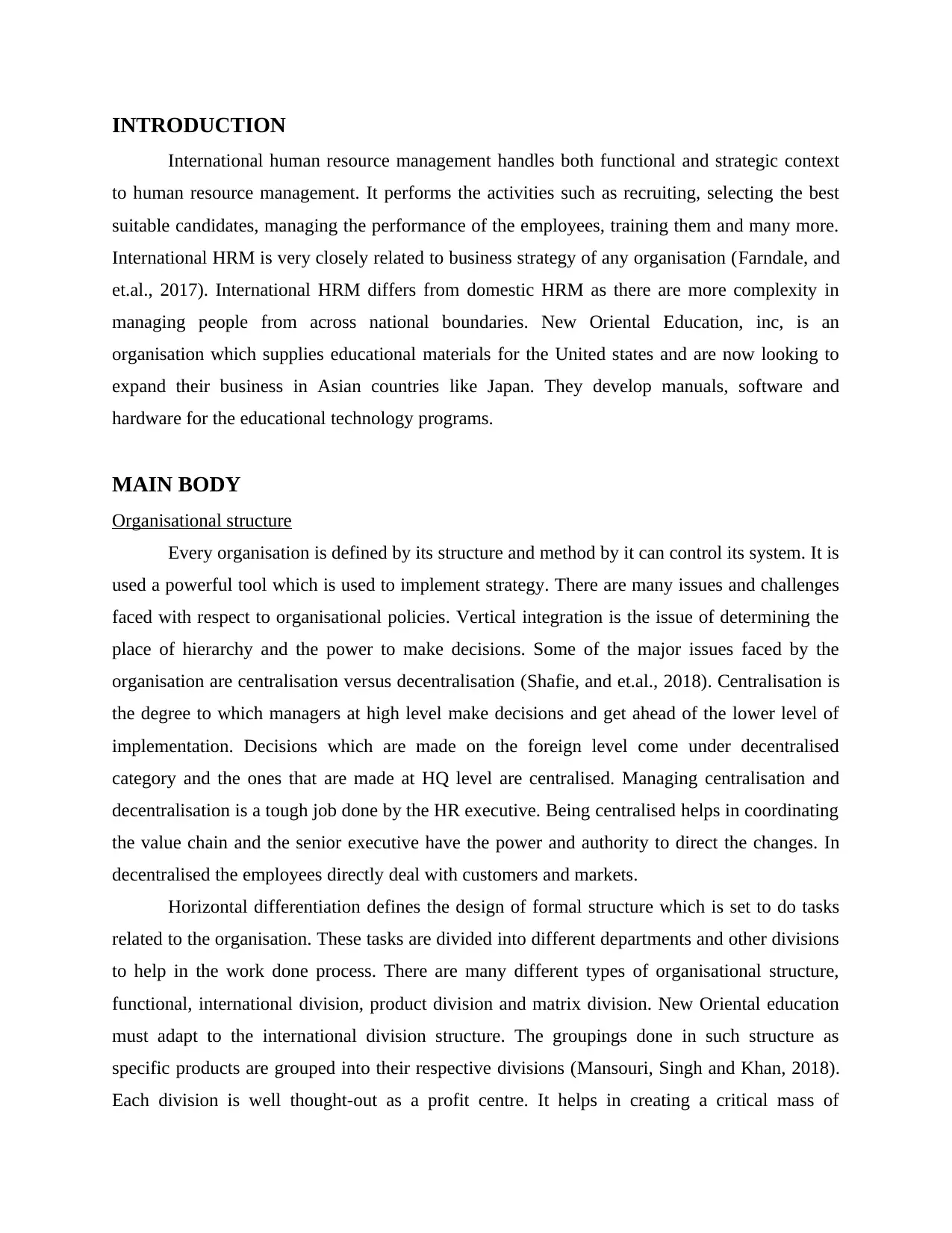
INTRODUCTION
International human resource management handles both functional and strategic context
to human resource management. It performs the activities such as recruiting, selecting the best
suitable candidates, managing the performance of the employees, training them and many more.
International HRM is very closely related to business strategy of any organisation (Farndale, and
et.al., 2017). International HRM differs from domestic HRM as there are more complexity in
managing people from across national boundaries. New Oriental Education, inc, is an
organisation which supplies educational materials for the United states and are now looking to
expand their business in Asian countries like Japan. They develop manuals, software and
hardware for the educational technology programs.
MAIN BODY
Organisational structure
Every organisation is defined by its structure and method by it can control its system. It is
used a powerful tool which is used to implement strategy. There are many issues and challenges
faced with respect to organisational policies. Vertical integration is the issue of determining the
place of hierarchy and the power to make decisions. Some of the major issues faced by the
organisation are centralisation versus decentralisation (Shafie, and et.al., 2018). Centralisation is
the degree to which managers at high level make decisions and get ahead of the lower level of
implementation. Decisions which are made on the foreign level come under decentralised
category and the ones that are made at HQ level are centralised. Managing centralisation and
decentralisation is a tough job done by the HR executive. Being centralised helps in coordinating
the value chain and the senior executive have the power and authority to direct the changes. In
decentralised the employees directly deal with customers and markets.
Horizontal differentiation defines the design of formal structure which is set to do tasks
related to the organisation. These tasks are divided into different departments and other divisions
to help in the work done process. There are many different types of organisational structure,
functional, international division, product division and matrix division. New Oriental education
must adapt to the international division structure. The groupings done in such structure as
specific products are grouped into their respective divisions (Mansouri, Singh and Khan, 2018).
Each division is well thought-out as a profit centre. It helps in creating a critical mass of
International human resource management handles both functional and strategic context
to human resource management. It performs the activities such as recruiting, selecting the best
suitable candidates, managing the performance of the employees, training them and many more.
International HRM is very closely related to business strategy of any organisation (Farndale, and
et.al., 2017). International HRM differs from domestic HRM as there are more complexity in
managing people from across national boundaries. New Oriental Education, inc, is an
organisation which supplies educational materials for the United states and are now looking to
expand their business in Asian countries like Japan. They develop manuals, software and
hardware for the educational technology programs.
MAIN BODY
Organisational structure
Every organisation is defined by its structure and method by it can control its system. It is
used a powerful tool which is used to implement strategy. There are many issues and challenges
faced with respect to organisational policies. Vertical integration is the issue of determining the
place of hierarchy and the power to make decisions. Some of the major issues faced by the
organisation are centralisation versus decentralisation (Shafie, and et.al., 2018). Centralisation is
the degree to which managers at high level make decisions and get ahead of the lower level of
implementation. Decisions which are made on the foreign level come under decentralised
category and the ones that are made at HQ level are centralised. Managing centralisation and
decentralisation is a tough job done by the HR executive. Being centralised helps in coordinating
the value chain and the senior executive have the power and authority to direct the changes. In
decentralised the employees directly deal with customers and markets.
Horizontal differentiation defines the design of formal structure which is set to do tasks
related to the organisation. These tasks are divided into different departments and other divisions
to help in the work done process. There are many different types of organisational structure,
functional, international division, product division and matrix division. New Oriental education
must adapt to the international division structure. The groupings done in such structure as
specific products are grouped into their respective divisions (Mansouri, Singh and Khan, 2018).
Each division is well thought-out as a profit centre. It helps in creating a critical mass of
Paraphrase This Document
Need a fresh take? Get an instant paraphrase of this document with our AI Paraphraser
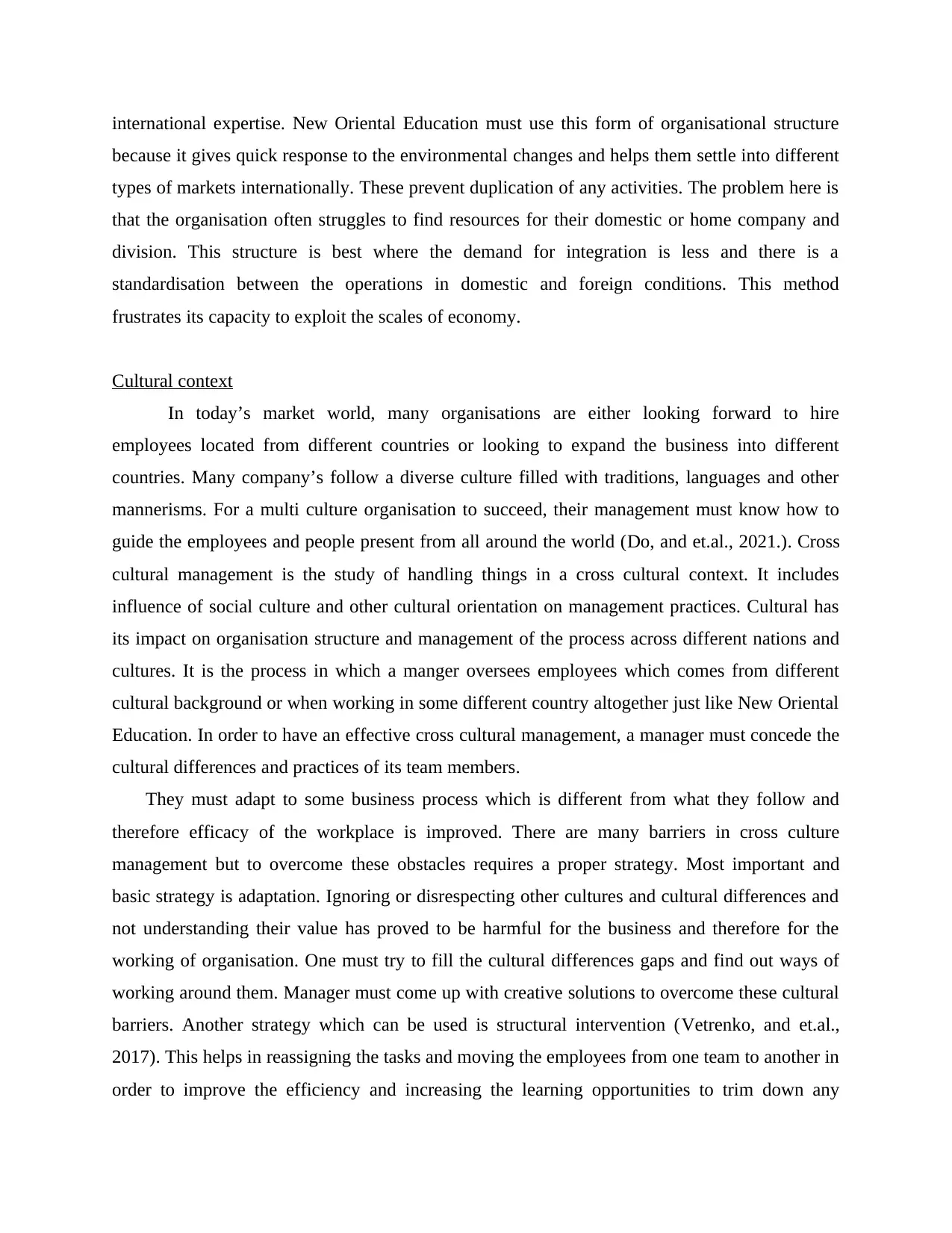
international expertise. New Oriental Education must use this form of organisational structure
because it gives quick response to the environmental changes and helps them settle into different
types of markets internationally. These prevent duplication of any activities. The problem here is
that the organisation often struggles to find resources for their domestic or home company and
division. This structure is best where the demand for integration is less and there is a
standardisation between the operations in domestic and foreign conditions. This method
frustrates its capacity to exploit the scales of economy.
Cultural context
In today’s market world, many organisations are either looking forward to hire
employees located from different countries or looking to expand the business into different
countries. Many company’s follow a diverse culture filled with traditions, languages and other
mannerisms. For a multi culture organisation to succeed, their management must know how to
guide the employees and people present from all around the world (Do, and et.al., 2021.). Cross
cultural management is the study of handling things in a cross cultural context. It includes
influence of social culture and other cultural orientation on management practices. Cultural has
its impact on organisation structure and management of the process across different nations and
cultures. It is the process in which a manger oversees employees which comes from different
cultural background or when working in some different country altogether just like New Oriental
Education. In order to have an effective cross cultural management, a manager must concede the
cultural differences and practices of its team members.
They must adapt to some business process which is different from what they follow and
therefore efficacy of the workplace is improved. There are many barriers in cross culture
management but to overcome these obstacles requires a proper strategy. Most important and
basic strategy is adaptation. Ignoring or disrespecting other cultures and cultural differences and
not understanding their value has proved to be harmful for the business and therefore for the
working of organisation. One must try to fill the cultural differences gaps and find out ways of
working around them. Manager must come up with creative solutions to overcome these cultural
barriers. Another strategy which can be used is structural intervention (Vetrenko, and et.al.,
2017). This helps in reassigning the tasks and moving the employees from one team to another in
order to improve the efficiency and increasing the learning opportunities to trim down any
because it gives quick response to the environmental changes and helps them settle into different
types of markets internationally. These prevent duplication of any activities. The problem here is
that the organisation often struggles to find resources for their domestic or home company and
division. This structure is best where the demand for integration is less and there is a
standardisation between the operations in domestic and foreign conditions. This method
frustrates its capacity to exploit the scales of economy.
Cultural context
In today’s market world, many organisations are either looking forward to hire
employees located from different countries or looking to expand the business into different
countries. Many company’s follow a diverse culture filled with traditions, languages and other
mannerisms. For a multi culture organisation to succeed, their management must know how to
guide the employees and people present from all around the world (Do, and et.al., 2021.). Cross
cultural management is the study of handling things in a cross cultural context. It includes
influence of social culture and other cultural orientation on management practices. Cultural has
its impact on organisation structure and management of the process across different nations and
cultures. It is the process in which a manger oversees employees which comes from different
cultural background or when working in some different country altogether just like New Oriental
Education. In order to have an effective cross cultural management, a manager must concede the
cultural differences and practices of its team members.
They must adapt to some business process which is different from what they follow and
therefore efficacy of the workplace is improved. There are many barriers in cross culture
management but to overcome these obstacles requires a proper strategy. Most important and
basic strategy is adaptation. Ignoring or disrespecting other cultures and cultural differences and
not understanding their value has proved to be harmful for the business and therefore for the
working of organisation. One must try to fill the cultural differences gaps and find out ways of
working around them. Manager must come up with creative solutions to overcome these cultural
barriers. Another strategy which can be used is structural intervention (Vetrenko, and et.al.,
2017). This helps in reassigning the tasks and moving the employees from one team to another in
order to improve the efficiency and increasing the learning opportunities to trim down any
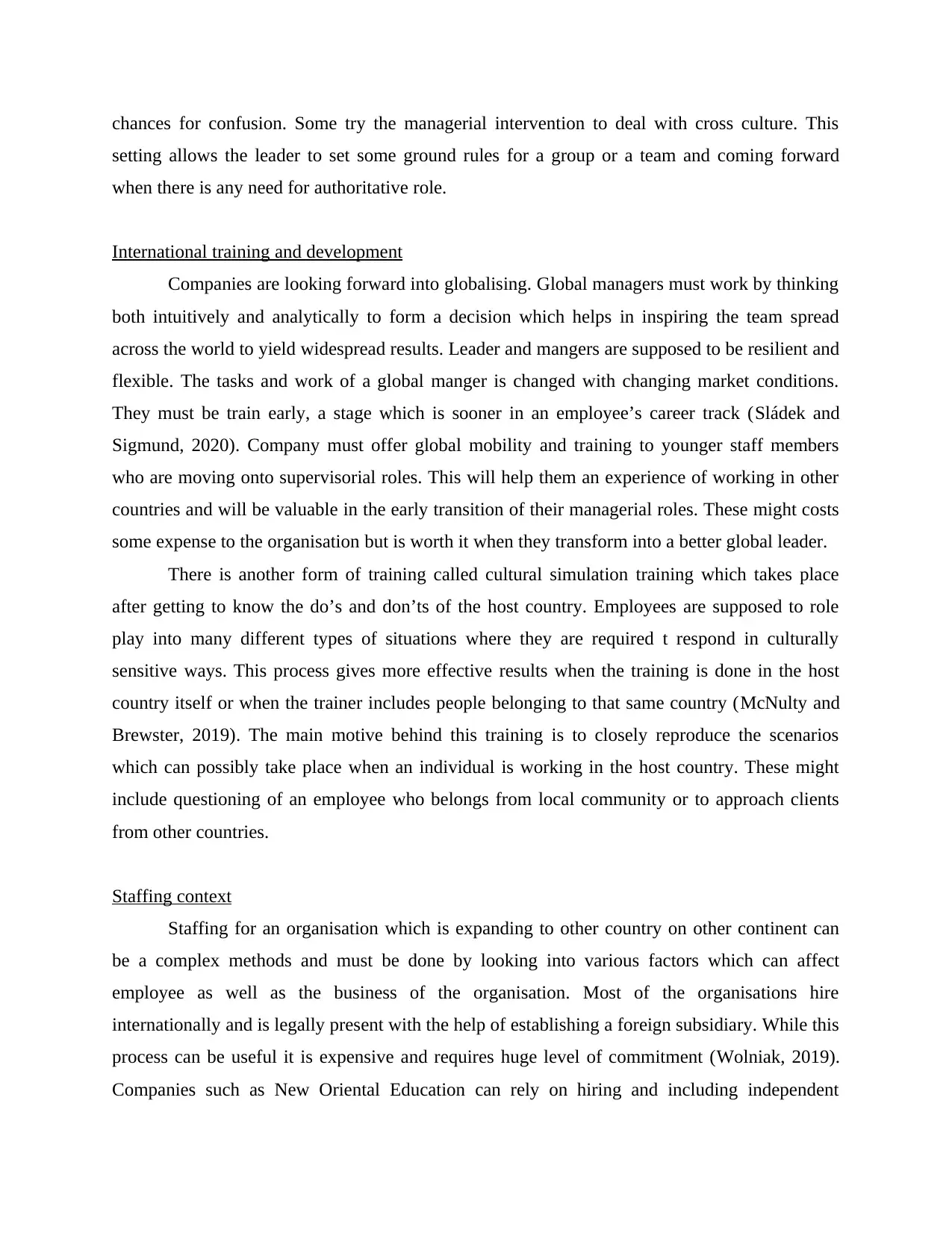
chances for confusion. Some try the managerial intervention to deal with cross culture. This
setting allows the leader to set some ground rules for a group or a team and coming forward
when there is any need for authoritative role.
International training and development
Companies are looking forward into globalising. Global managers must work by thinking
both intuitively and analytically to form a decision which helps in inspiring the team spread
across the world to yield widespread results. Leader and mangers are supposed to be resilient and
flexible. The tasks and work of a global manger is changed with changing market conditions.
They must be train early, a stage which is sooner in an employee’s career track (Sládek and
Sigmund, 2020). Company must offer global mobility and training to younger staff members
who are moving onto supervisorial roles. This will help them an experience of working in other
countries and will be valuable in the early transition of their managerial roles. These might costs
some expense to the organisation but is worth it when they transform into a better global leader.
There is another form of training called cultural simulation training which takes place
after getting to know the do’s and don’ts of the host country. Employees are supposed to role
play into many different types of situations where they are required t respond in culturally
sensitive ways. This process gives more effective results when the training is done in the host
country itself or when the trainer includes people belonging to that same country (McNulty and
Brewster, 2019). The main motive behind this training is to closely reproduce the scenarios
which can possibly take place when an individual is working in the host country. These might
include questioning of an employee who belongs from local community or to approach clients
from other countries.
Staffing context
Staffing for an organisation which is expanding to other country on other continent can
be a complex methods and must be done by looking into various factors which can affect
employee as well as the business of the organisation. Most of the organisations hire
internationally and is legally present with the help of establishing a foreign subsidiary. While this
process can be useful it is expensive and requires huge level of commitment (Wolniak, 2019).
Companies such as New Oriental Education can rely on hiring and including independent
setting allows the leader to set some ground rules for a group or a team and coming forward
when there is any need for authoritative role.
International training and development
Companies are looking forward into globalising. Global managers must work by thinking
both intuitively and analytically to form a decision which helps in inspiring the team spread
across the world to yield widespread results. Leader and mangers are supposed to be resilient and
flexible. The tasks and work of a global manger is changed with changing market conditions.
They must be train early, a stage which is sooner in an employee’s career track (Sládek and
Sigmund, 2020). Company must offer global mobility and training to younger staff members
who are moving onto supervisorial roles. This will help them an experience of working in other
countries and will be valuable in the early transition of their managerial roles. These might costs
some expense to the organisation but is worth it when they transform into a better global leader.
There is another form of training called cultural simulation training which takes place
after getting to know the do’s and don’ts of the host country. Employees are supposed to role
play into many different types of situations where they are required t respond in culturally
sensitive ways. This process gives more effective results when the training is done in the host
country itself or when the trainer includes people belonging to that same country (McNulty and
Brewster, 2019). The main motive behind this training is to closely reproduce the scenarios
which can possibly take place when an individual is working in the host country. These might
include questioning of an employee who belongs from local community or to approach clients
from other countries.
Staffing context
Staffing for an organisation which is expanding to other country on other continent can
be a complex methods and must be done by looking into various factors which can affect
employee as well as the business of the organisation. Most of the organisations hire
internationally and is legally present with the help of establishing a foreign subsidiary. While this
process can be useful it is expensive and requires huge level of commitment (Wolniak, 2019).
Companies such as New Oriental Education can rely on hiring and including independent
⊘ This is a preview!⊘
Do you want full access?
Subscribe today to unlock all pages.

Trusted by 1+ million students worldwide
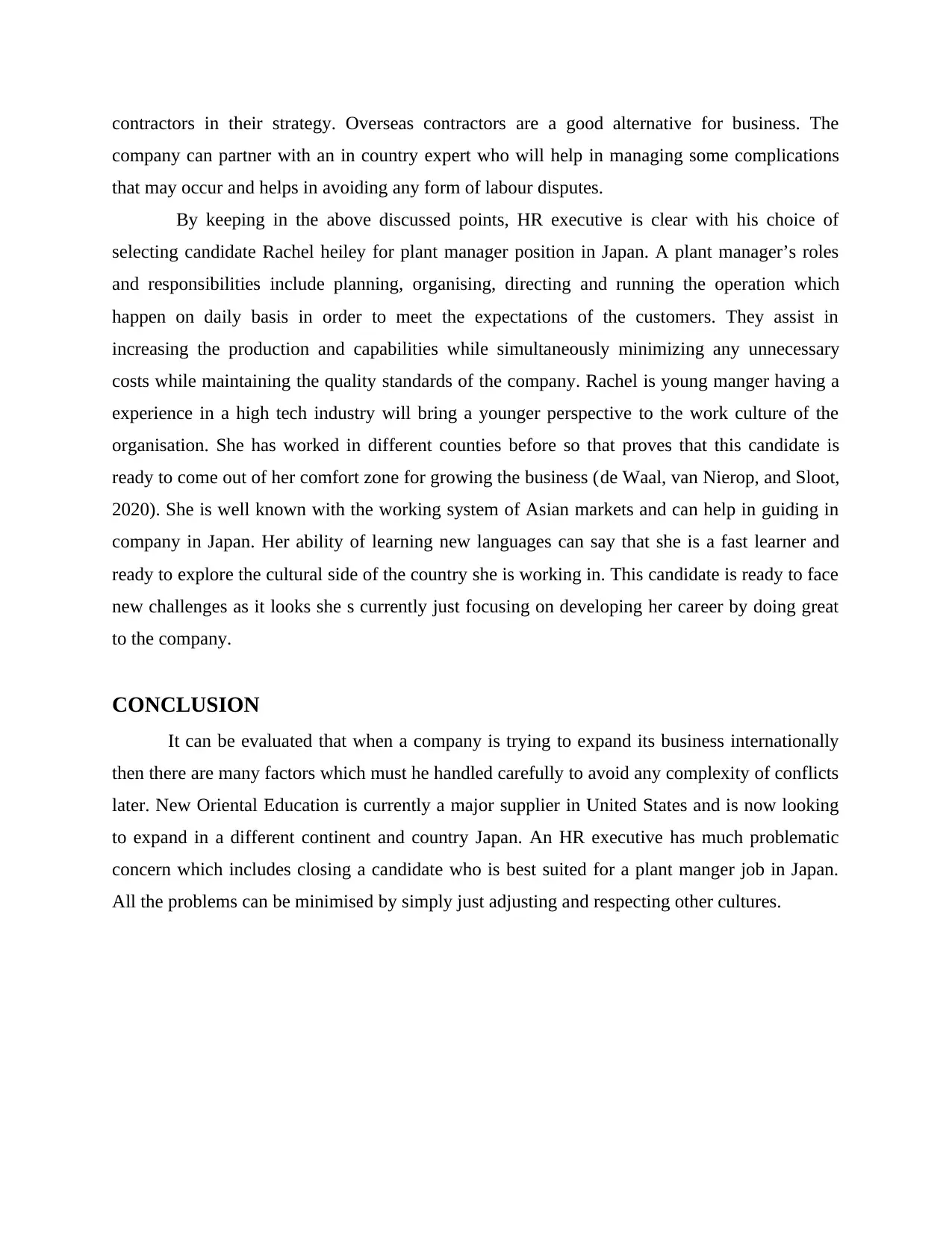
contractors in their strategy. Overseas contractors are a good alternative for business. The
company can partner with an in country expert who will help in managing some complications
that may occur and helps in avoiding any form of labour disputes.
By keeping in the above discussed points, HR executive is clear with his choice of
selecting candidate Rachel heiley for plant manager position in Japan. A plant manager’s roles
and responsibilities include planning, organising, directing and running the operation which
happen on daily basis in order to meet the expectations of the customers. They assist in
increasing the production and capabilities while simultaneously minimizing any unnecessary
costs while maintaining the quality standards of the company. Rachel is young manger having a
experience in a high tech industry will bring a younger perspective to the work culture of the
organisation. She has worked in different counties before so that proves that this candidate is
ready to come out of her comfort zone for growing the business (de Waal, van Nierop, and Sloot,
2020). She is well known with the working system of Asian markets and can help in guiding in
company in Japan. Her ability of learning new languages can say that she is a fast learner and
ready to explore the cultural side of the country she is working in. This candidate is ready to face
new challenges as it looks she s currently just focusing on developing her career by doing great
to the company.
CONCLUSION
It can be evaluated that when a company is trying to expand its business internationally
then there are many factors which must he handled carefully to avoid any complexity of conflicts
later. New Oriental Education is currently a major supplier in United States and is now looking
to expand in a different continent and country Japan. An HR executive has much problematic
concern which includes closing a candidate who is best suited for a plant manger job in Japan.
All the problems can be minimised by simply just adjusting and respecting other cultures.
company can partner with an in country expert who will help in managing some complications
that may occur and helps in avoiding any form of labour disputes.
By keeping in the above discussed points, HR executive is clear with his choice of
selecting candidate Rachel heiley for plant manager position in Japan. A plant manager’s roles
and responsibilities include planning, organising, directing and running the operation which
happen on daily basis in order to meet the expectations of the customers. They assist in
increasing the production and capabilities while simultaneously minimizing any unnecessary
costs while maintaining the quality standards of the company. Rachel is young manger having a
experience in a high tech industry will bring a younger perspective to the work culture of the
organisation. She has worked in different counties before so that proves that this candidate is
ready to come out of her comfort zone for growing the business (de Waal, van Nierop, and Sloot,
2020). She is well known with the working system of Asian markets and can help in guiding in
company in Japan. Her ability of learning new languages can say that she is a fast learner and
ready to explore the cultural side of the country she is working in. This candidate is ready to face
new challenges as it looks she s currently just focusing on developing her career by doing great
to the company.
CONCLUSION
It can be evaluated that when a company is trying to expand its business internationally
then there are many factors which must he handled carefully to avoid any complexity of conflicts
later. New Oriental Education is currently a major supplier in United States and is now looking
to expand in a different continent and country Japan. An HR executive has much problematic
concern which includes closing a candidate who is best suited for a plant manger job in Japan.
All the problems can be minimised by simply just adjusting and respecting other cultures.
Paraphrase This Document
Need a fresh take? Get an instant paraphrase of this document with our AI Paraphraser
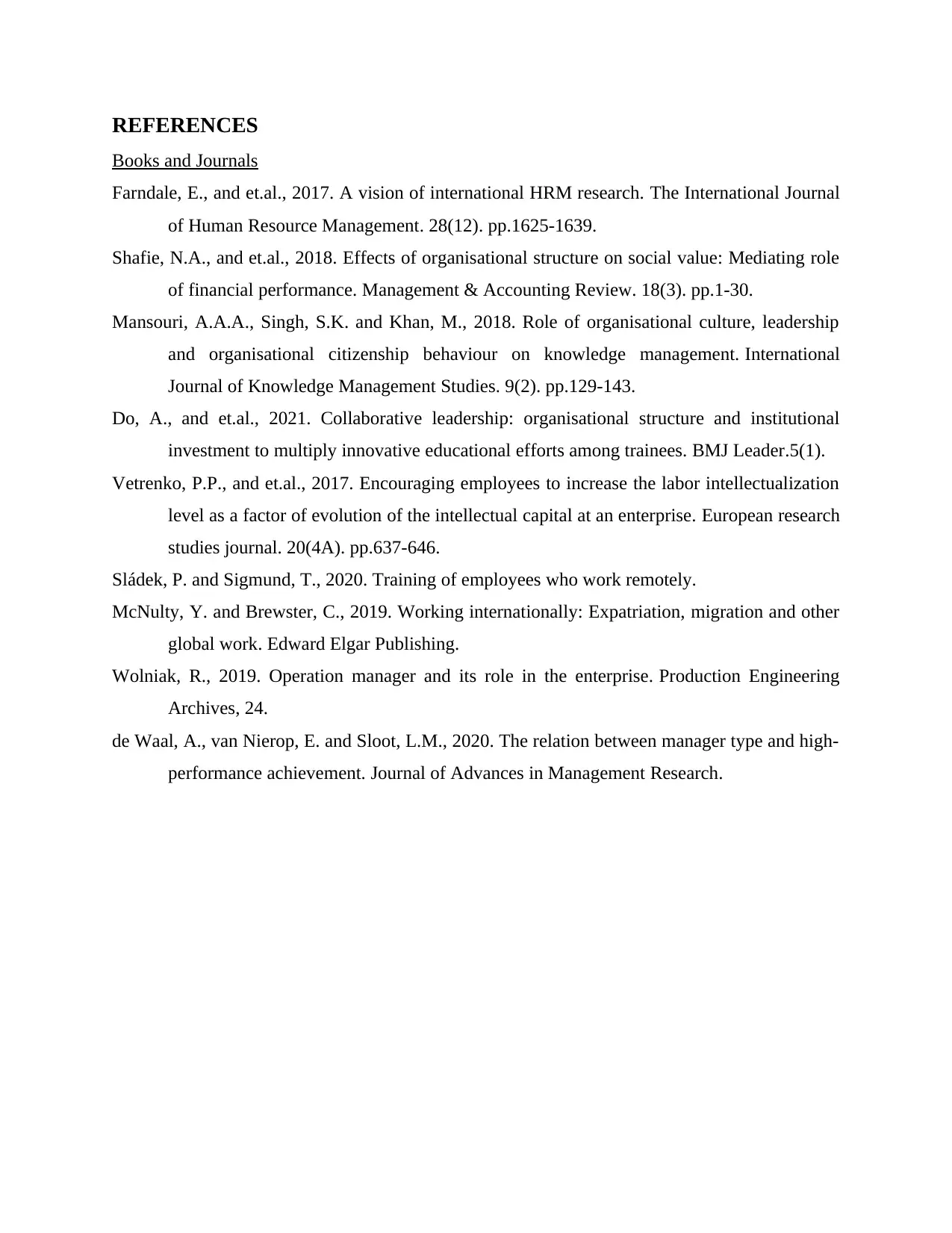
REFERENCES
Books and Journals
Farndale, E., and et.al., 2017. A vision of international HRM research. The International Journal
of Human Resource Management. 28(12). pp.1625-1639.
Shafie, N.A., and et.al., 2018. Effects of organisational structure on social value: Mediating role
of financial performance. Management & Accounting Review. 18(3). pp.1-30.
Mansouri, A.A.A., Singh, S.K. and Khan, M., 2018. Role of organisational culture, leadership
and organisational citizenship behaviour on knowledge management. International
Journal of Knowledge Management Studies. 9(2). pp.129-143.
Do, A., and et.al., 2021. Collaborative leadership: organisational structure and institutional
investment to multiply innovative educational efforts among trainees. BMJ Leader.5(1).
Vetrenko, P.P., and et.al., 2017. Encouraging employees to increase the labor intellectualization
level as a factor of evolution of the intellectual capital at an enterprise. European research
studies journal. 20(4A). pp.637-646.
Sládek, P. and Sigmund, T., 2020. Training of employees who work remotely.
McNulty, Y. and Brewster, C., 2019. Working internationally: Expatriation, migration and other
global work. Edward Elgar Publishing.
Wolniak, R., 2019. Operation manager and its role in the enterprise. Production Engineering
Archives, 24.
de Waal, A., van Nierop, E. and Sloot, L.M., 2020. The relation between manager type and high-
performance achievement. Journal of Advances in Management Research.
Books and Journals
Farndale, E., and et.al., 2017. A vision of international HRM research. The International Journal
of Human Resource Management. 28(12). pp.1625-1639.
Shafie, N.A., and et.al., 2018. Effects of organisational structure on social value: Mediating role
of financial performance. Management & Accounting Review. 18(3). pp.1-30.
Mansouri, A.A.A., Singh, S.K. and Khan, M., 2018. Role of organisational culture, leadership
and organisational citizenship behaviour on knowledge management. International
Journal of Knowledge Management Studies. 9(2). pp.129-143.
Do, A., and et.al., 2021. Collaborative leadership: organisational structure and institutional
investment to multiply innovative educational efforts among trainees. BMJ Leader.5(1).
Vetrenko, P.P., and et.al., 2017. Encouraging employees to increase the labor intellectualization
level as a factor of evolution of the intellectual capital at an enterprise. European research
studies journal. 20(4A). pp.637-646.
Sládek, P. and Sigmund, T., 2020. Training of employees who work remotely.
McNulty, Y. and Brewster, C., 2019. Working internationally: Expatriation, migration and other
global work. Edward Elgar Publishing.
Wolniak, R., 2019. Operation manager and its role in the enterprise. Production Engineering
Archives, 24.
de Waal, A., van Nierop, E. and Sloot, L.M., 2020. The relation between manager type and high-
performance achievement. Journal of Advances in Management Research.

⊘ This is a preview!⊘
Do you want full access?
Subscribe today to unlock all pages.

Trusted by 1+ million students worldwide
1 out of 9
Related Documents
Your All-in-One AI-Powered Toolkit for Academic Success.
+13062052269
info@desklib.com
Available 24*7 on WhatsApp / Email
![[object Object]](/_next/static/media/star-bottom.7253800d.svg)
Unlock your academic potential
Copyright © 2020–2025 A2Z Services. All Rights Reserved. Developed and managed by ZUCOL.





